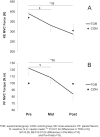Alterations of Neuromuscular Function after the World's Most Challenging Mountain Ultra-Marathon
- PMID: 23840345
- PMCID: PMC3694082
- DOI: 10.1371/journal.pone.0065596
Alterations of Neuromuscular Function after the World's Most Challenging Mountain Ultra-Marathon
Abstract
We investigated the physiological consequences of the most challenging mountain ultra-marathon (MUM) in the world: a 330-km trail run with 24000 m of positive and negative elevation change. Neuromuscular fatigue (NMF) was assessed before (Pre-), during (Mid-) and after (Post-) the MUM in experienced ultra-marathon runners (n = 15; finish time = 122.43 hours ±17.21 hours) and in Pre- and Post- in a control group with a similar level of sleep deprivation (n = 8). Blood markers of muscle inflammation and damage were analyzed at Pre- and Post-. Mean ± SD maximal voluntary contraction force declined significantly at Mid- (-13±17% and -10±16%, P<0.05 for knee extensor, KE, and plantar flexor muscles, PF, respectively), and further decreased at Post- (-24±13% and -26±19%, P<0.01) with alteration of the central activation ratio (-24±24% and -28±34% between Pre- and Post-, P<0.05) in runners whereas these parameters did not change in the control group. Peripheral NMF markers such as 100 Hz doublet (KE: -18±18% and PF: -20±15%, P<0.01) and peak twitch (KE: -33±12%, P<0.001 and PF: -19±14%, P<0.01) were also altered in runners but not in controls. Post-MUM blood concentrations of creatine kinase (3719±3045 Ul·(1)), lactate dehydrogenase (1145±511 UI·L(-1)), C-Reactive Protein (13.1±7.5 mg·L(-1)) and myoglobin (449.3±338.2 µg·L(-1)) were higher (P<0.001) than at Pre- in runners but not in controls. Our findings revealed less neuromuscular fatigue, muscle damage and inflammation than in shorter MUMs. In conclusion, paradoxically, such extreme exercise seems to induce a relative muscle preservation process due likely to a protective anticipatory pacing strategy during the first half of MUM and sleep deprivation in the second half.
Conflict of interest statement
Figures






References
-
- Hoffman MD, Ingwerson JL, Rogers IR, Hew-Butler T, Stuempfle KJ (2012) Increasing creatine kinase concentrations at the 161-km Western States Endurance Run. Wilderness & environmental medicine 23: 56–60. - PubMed
-
- Millet GY, Lepers R, Maffiuletti NA, Babault N, Martin V, et al. (2002) Alterations of neuromuscular function after an ultramarathon. Journal of applied physiology 92: 486–492. - PubMed
-
- Robach P, Boisson RC, Vincent L, Lundby C, Moutereau S, et al.. (2012) Hemolysis induced by an extreme mountain ultra-marathon is not associated with a decrease in total red blood cell volume. Scandinavian journal of medicine & science in sports. - PubMed
MeSH terms
LinkOut - more resources
Full Text Sources
Other Literature Sources
Research Materials

